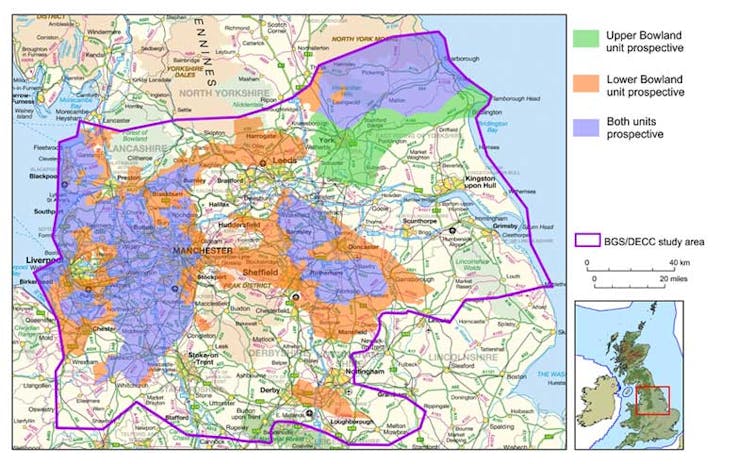Over the past decade, the UK has tentatively begun to exploit its reserves of shale gas through a process best known as “fracking”. But according to our new research, UK shale reserves are substantially lower than previously thought – in fact, the amount of shale gas available may be just one sixth of the current official estimate.
Back in 2013, a UK government study estimated how much gas could be found in Bowland Shale. “A shale” consists of the sort of sedimentary rocks in which oil and gas can be formed – while “shale gas” is the gas formed but not yet released into reservoirs. The Bowland, stretching from Lancashire, across the Pennines and down into the Midlands, is the country’s largest and most economically viable shale. The 2013 study estimated that Bowland shale alone could provide the UK with up to 50 years of gas at current demand.
But it turns out this was a big over-estimate. At the time, scientists didn’t know much about the Bowland shale and didn’t have any published production data to work off. This meant they estimated the size of the reserves based on models that were developed for shales in the US, without taking into account key differences between shale gas in the two countries.

British Geological Society
Further, the estimate was based on how much gas scientists thought the rocks could contain, rather that the actual amount the rocks were able to “generate”. Plus, initial estimates of this gas holding capacity may have been inflated as they overlooked the effect on moisture, which is known to reduce the amount of gas held within the shale.
Read Also: Research Fraud, the temptation to lie and the challenges of regulation.
Our findings, now published in the journal Nature Communications, are the result of 11 years work developing a way to simulate in a lab the conditions that rocks would be exposed to deep underground, and therefore figure out how much oil or gas these rocks would “generate”. We then applied this method to shale gas, which meant we were able to measure and estimate shale reserves.
1,300 trillion… down to 200 trillion shale gas reserves
We estimate that the maximum reserves for the Bowland Shale are around 200 standard trillion cubic feet – that’s less than a sixth of the 2013 estimate of around 1,300 trillion cubic ft. Assuming 10% of the reserves are economically recoverable – a fairly optimistic scenario – this corresponds to no more than ten years’ UK gas supply at current demand.
Any predictive method will inevitably involve a degree of uncertainty, and both our study and the original 2013 report can only report a range of possible values, with the central prediction being the most probable. A truly foolproof way of assessing how much gas is buried below the UK, and how much is economically recoverable, could only come from widespread test drilling.
So for now, more tests will be needed to reduce the degree of uncertainty. However, our findings can inform government decisions around the future of shale in the UK, as the country moves towards being carbon neutral by 2050.
Carbon neutrality means natural gas can only be used either to generate electricity when combined with carbon capture and storage, or potentially to produce hydrogen for transport or domestic heating. Given the scale of the roll-out needed for carbon capture, it is likely that UK consumption will fall over the next 30 years, therefore extending the life of reserves including both UK shale, and less controversially, conventional gas from the North Sea.
Will Meredith, Assistant Professor in Fuel Science and Technology, University of Nottingham and Colin Snape, Director of Engineering Doctorate Centre in Efficient Fossil Energy Technologies , University of Nottingham
This article is republished from The Conversation under a Creative Commons license. Read the original article.